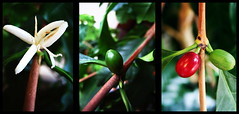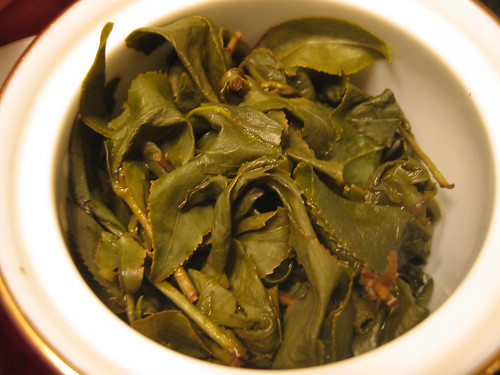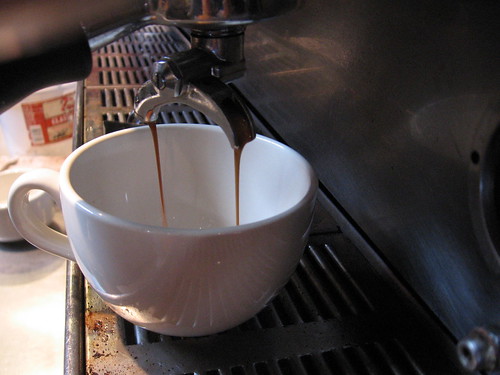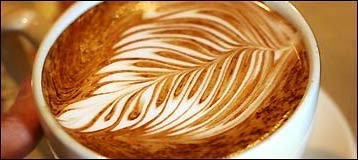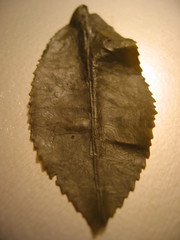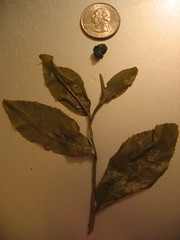The
home-barista.com sponsored Tamper Roadshow rolled through Cambridge recently and this is our take on this massive lineup of tampers.
 Bumper
Bumperhandle: black rubber handle
width: 1 5/8"
base: stainless steel, satin-brush finish
weight: 1lb 3/4oz
height: 3 1/2"
First Impression:At first glance, the Bumper tamper looks cheap. However, when I actually picked it up, the weight (of the tamper) and the feel of the rubber really surprised me. In fact, it duplicated the feel of an OEM rubber handle for the La Marzocco portafilter. Very comfortable and solid.
Handle:The handle is that of the classic tamper shape and it worked quite well. I personally would like the top to be a bit wider and taller so I can cradle it with my ring and pinky fingers, but Jaime liked it quite a bit (since he was trained on the same shape). The rubberized handle takes a lot of abuse w/out showing much damage and won’t absorb much nasty stale coffee odors.
Base:The base of the Bumper is the thickest of all tampers from the road show. With our style of dosing/tamping (Tim Wendelboe’s under the line style), it’s hard to gauge what kind of dosage is in the basket. The tapered side is quite comfortable for the thumb and the forefinger, however.
Bottom Line:A solid work horse that can take the abuse of a busy café.
 Coffeelab Design
Coffeelab Designhandle: anodized and powder coated aluminum with rubber grip handle
width: 1 1/2"
base: stainless steel, satin-brush finish
weight: 13 3/8oz
height: 3 5/8"
First Impression:This tamper has a toy look to it, probably due to the use of different material/colors. The neck of then handle also looks flimsy.
Handle:The grip is actually a lot more comfortable than it looks, and the adjustable spacer at the neck is a good idea. However, the combination of the very thin neck and the small size of the connection screw gives off a very un-secured feeling. More than 3 of us feel we could snap it with excessive force. Not too sure about the long term durability in a busy/abusive café environment.
Base:The rubber pad and the slope are very comfortable for the forefinger and thumb to rest/press on.
Bottom Line:Very comfortable tamper that falls short on the overall durability.
 EPNW Compressore
EPNW Compressore handle: powder coated aluminum handle
width: 1 7/8" base: stainless steel
weight: 1lb 1 3/4oz
height: 3 9/16"
First Impression:Part of the EPNW tamper lineup. The anodized finish is quite attractive.
Handle:The large bulbous handle is really designed for very large hands. The head is even a bit too big for my palm and the neck is not thin enough for my middle finger to get a good grip. The anodized finish is durable and won’t absorb any funny odors.
Base:Nice tapered sides and thickness. This is our “standard” and preferred tamper base.
Bottom Line:A solid tamper for large hands.
 EPNW EP5
EPNW EP5 handle: polished Bulbinga wood handle
width: 1 3/4" base: stainless steel
weight: 13 oz
height: 3 3/16"
First Impression:Part of the EPNW tamper lineup. The handle looks quite small.
Handle:Short and bulky handle designed for short stubby hands. Glossy clear coat protects from dirt/odor contamination, but can wear out with use.
Base:Standard EPNW base we loved.
Bottom Line:Tamper for large but stubby handed home user.
 Espressocraft
Espressocrafthandle: stainless steel handle width: 1 3/4"
base: brushed stainless steel
weight: 14 5/8oz
height: 3 1/2"
First Impression:The fit and finish is amazing. The precision machined stainless steel are the main reason behind the cost and it’s worth every penny.
Handle:The most comfortable of all tampers I’ve used. The length and the shape of the handle allowed me to place my ring and pinky finger on top comfortably while providing a secured grip with my middle finger around the neck. The curvature/thickness at the base of the handle allowed me to spread my fore-finger and thumb comfortably. The brushed stainless finish was hard and proves sanitary, though I could see the nice surface being scratched/dinged up from use.
Base:While the fillet at the neck fits the fingers comfortably, there is no overall slope to the base. This forced you to place your forefinger and thumb at the center of the base instead of spreading out across the entire diameter. This makes leveling a bit more difficult and feels wobbly. The base is also a bit thin which makes it difficult to use with our dosing method. It could work with over doses though.
Bottom Line:Beautiful metal sculpture for triple ristretto style café.
 EPNW Lava Import
EPNW Lava Importhandle: machine milled aluminum
handle width: 1 3/4"
base: stainless steel
weight: 3 1/4"
height: 9 oz
First Impression:My current tamper is a Lava deluxe, and this tamper looks and feels like a bad rip-off version of it.
Handle:The handle is too short for me to get a good grip. It also feels very cheap due to the weight and finish.
Base:This is a bad joke, right? The thing is metal but hollow, and has no substantial weight at all. It felt like a real (cheap) toy.
Bottom Line:A cheap taste of real tamper for first time home user.
 La Forza
La Forzahandle: handpainted glazed ceramic handle
width: 2"
base: stainless steel
weight: 14 5/8oz
height: 3 1/2"
First Impression:Is this for real use?!
Handle:The ceramic handle is not centered and already has chips when it arrived. The head is way too big and bulbous. I cannot get a good grip on it. I am not sure I will use this as a tool.
Base:Standard EPNW base.
Bottom Line:Pretty decorative tamper for occasional uses.
 EPNW Lava Deluxe
EPNW Lava Deluxehandle: machine milled aluminum handle
width: 1 3/4"
base: stainless steel
weight: 14 1/2oz
height: 3 1/4"
First Impression:This is my current tamper. I previously bought it because it was not wood and orange…
Handle:A little too short for me to get a good grip. The aluminum top damages easily and after 1+ year of home use, it already looks quite abused.
Base:Standard EPNW base.
Bottom Line:Solid, affordable tamper for smaller hands.
 EPNW Pro
EPNW Pro handle: machined milled aluminum handle
width: 1 1/2"
base: stainless steel
weight: 1lb 3 1/4oz
height: 3 3/8"
First Impression:Classic café tamper.
Handle:Good shape for a flashlight style grip. I found the top to be a bit small to be totally comfortable with it but Jaime loves it. The very top is inlayed with delrin so tapping won’t damage the metal finish.
Base:Good taper and height that lends to easy leveling when using volumetric dosing.
Bottom Line:No-nonsense and durable utilitarian work horse for café.
 Pullman
Pullmanhandle: oiled, resin impregnated hardwood handle
width: 2"
base: stainless steel with TrueTamp guide rings
overall weight: 15 oz
overall height: 3 5/8"
First Impression:The fit and finish showed high level of worksmanship. The sharp edges of the handle and the base made it look a bit uncomfortable.
Handle:The sharp transition from the head to the neck looked very uncomfortable at first but is actually quite comfortable in use. The shape provides a very secured feeling from the grip. The hardwood has no clear coat finish and will absorb a lot of (bad) odors from use. It smelled really bad from previous users when we first open the box.
Base:The taper at the sides is a bit short but big enough to allow a nice spread of the index finger and thumb for a stable, level tamp. The base is a bit thicker than other tampers but the machined indicator lines around the perimeter provide good feedback on the level and dose.
Bottom Line:Comfortable and solid tamper for home use.
 Reg Barber Radical Pro
Reg Barber Radical Prohandle: African Rosewood handle
width: 1 1/8"
base: stainless steel
weight: 11 oz
height: 4 3/8"
First Impression:Radical look for sure. The handle is a lot smaller than it appeared to be in the photo.
Handle:The shape and length of the handle forces you to apply all your forces thru your thumb and index finger. While it forces you to use a straight wrist (or it will hurt you dearly), you can be too far forward with your tamp easily. Judson really loved this shape while the rest of us hated it (it physically hurt me). While the wooden handle is finished with a clear coat, it already showed discoloration from the road show. This is definitely a long term durability concern.
Base:Similar taper and thickness as the EPNW one, but with a better metal finish.
Bottom Line:Unconventionally shaped tamper for someone special.
 Reg Barger HB logo'd
Reg Barger HB logo'dhandle: Tall - African Rosewood handle
width: 1 13/16"
base: stainless steel, satin-brush finish
weight: 12 1/4oz
height: 3 1/2"
First Impression:The reg that most ppl seemed to love.
Handle:The shape is an update to the classic café tamper shape. It provides a comfortable and secured grip. I personally would like it to be a little bit taller though. Being made of wood, it really is not so suitable to be used in a busy café environment due to durability and sanitary issues.
Base:Similar taper and thickness as the EPNW one but with better finish.
Bottom Line:The quintessential home barista tamper.
 Cafe Kultur TORR Classic
Cafe Kultur TORR Classic handle: African Blackwood, handpolished, glossy finish handle
width: 1 13/16"
base: stainless steel, matt finish
weight: 13 3/4oz
height: 3 3/4"
First Impression:The fit and finish of the TORR is first class. I especially appreciate the fillet edge of the base.
Handle:The large handle would be almost comfortable had it not been so tall. The bulbous head to neck transition does not provide as secured grip as others. The smooth finish of the wood feels very nice but most likely will not stand up to the abuse of heavy use.
Base:The flat base forces you to press at the center of the handle which made leveling difficult and uncomfortable. The inward taper of the perimeter is perplexing because it actually looks off-level when it is actually fine.
Bottom Line:Home use tamper with a unique base for large hands.
 Thor
Thorhandle: polished wood handle
width: 2"
base: polished wood - Lignum Vitae or Blackwood
weight: 12 3/4oz
height: 3 11/16"
First Impression:Who stole my pepper grinder?!
Handle:I don’t know how to grip or level with this thing.
Base:Um… it’s flat?
Bottom Line:Why spend so much time and energy to create so much nothingness?
 EPNW Clicker
EPNW Clickerhandle: black rubber handle width: 1 3/4"
base: stainless steel, satin-brush finish
weight: 1lb 2 3/4oz
height: 4 3/8"
First Impression:This is supposed to be a training tool for beginners.
Handle:Quite comfortable gripe actually, but you cannot level with this thing due to the double decker design. Very difficult to balance so I am not sure how good of a learning tool it is (you are not learning the proper way to level the tamp). The click is something else…
Base:Does not really matter as you cannot see or touch it when tamping.
Bottom Line:A proper tamper and a scale might be a better training tool…
